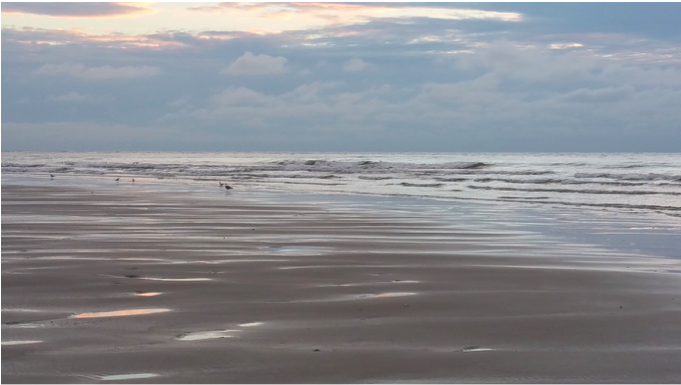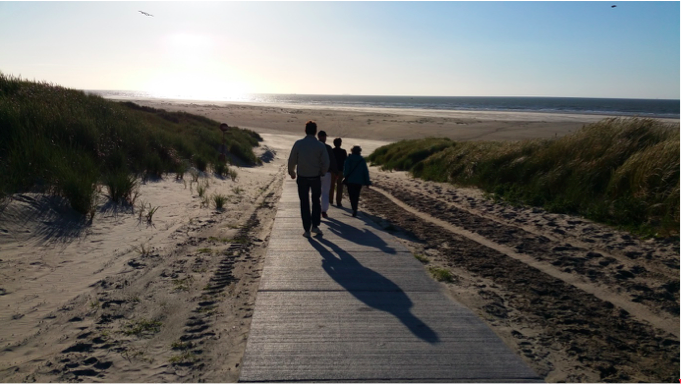I’ve just spent a week on the beautiful island of Terschelling learning the second official language of the Netherlands: Frisian. Friesland is a northern province with a long coastal line and a cluster of stunning islands. The archipelago of islands forms a chain along the coast of north-western Europe and belong not just to the Netherlands but also to Germany and Denmark as you proceed further north. Terschelling (Skylge in Frisian) has long been my favourite holiday destination in the Netherlands. It combines sweeping sandy beaches with dunes, pine forests and a large nature reserve. Think elaborately-layered skies, huge expanses of sand, and seabirds.
I was one of four Dutch-to-English translators invited on a beginner’s crash course in Frisian. A forthcoming anthology of Frisian literature needs to be translated for a British publisher and we’ll be rolling up our sleeves. The plan is to continue to improve our Frisian over the coming months, but luckily there will also be a Dutch translation we can consult. No one in their right mind would agree to translate from a language they’ve learned in a week. Years of exposure and cultural immersion are necessary to understand all the nuances of a language and produce a good translation. That said, the course was pretty intensive – right from the start we were taught in Frisian by the brilliant Anne Tjerk Popkema (Frisian men tend to be called either Anne or Tjerk – he has both), the translator of The Hobbit, amongst other books.
The reason we could understand enough Frisian to be taught in it is because it is from the same language family as Dutch (Germanic). The two languages have existed side by side throughout the centuries and given that all Frisians are bilingual and also speak Dutch, there’s been a fair amount of linguistic seepage. So far so good. But there’s an added complication. There isn’t just one type of Frisian. Broadly speaking, there are actually three different regional variations of the language. And like many minority languages, it tends to be spoken rather than written, so spellings vary individually. What we were learning was a kind of standardized Frisian that no one actually speaks.
Many of the words sound like Dutch words but once they’ve been written down, it’s harder to recognize them. And as in many related languages, there are ‘false friends’. Net in Dutch (just) is not the same as net in Frisian (not). A humorous advert plays with this distinction by having Frisians say ‘Het kan net’ (It’s not possible) to Dutch tourists who refuse to go away. Frisian is sometimes described as English’s first cousin, though to be honest, modern Frisian would be completely unintelligible to monoglot English speakers and more likely to be understood by Dutch, Germans and Danes. Old forms of Frisian are clearly related to (old) English, however, and have shared words like the and that.
Most people have heard of Frisian cows and there is a link: the first Frisians were cattle farmers, though the cows came in all shapes and sizes back then, around 3400BC. They weren’t the pretty black-and-white variety we have today. Other famous Frisian exports include horses (Dan Brown and his wife breed them), the dancing spy Mata Hari and supermodel Doutzen Kroes. The islands of Terschelling and Vlieland also produce cranberries. ‘Cranberries: good for pissing’ was printed on the stickers from one gift shop I visited to buy a thank you present for my mum who’d been looking after my kids all week. By then I’d learned enough Frisian to figure out the mistake – the Frisian verb to pee is pisje.
A surprise test on the last day of the course revealed my geographical ignorance of the area. The famous 200km-long skating tour, the Elfstedentocht, goes through eleven Frisian towns. I’m going to learn them off by heart in both languages in case I ever get tested again. Repeat after me: Ljouwert (Leeuwarden), Snits (Sneek), Drylts (IJlst), Sleat (Sloten), Starum (Stavorum), Hylpen (Hinderloopen), Warkum (Workum), Boalsert (Bolsward), Harns (Harlingen), Frjentsjer (Franeker), Dokkum (Dokkum).
With thanks to AFUK, the Dutch Foundation for Literature and Provincie Fryslân.



